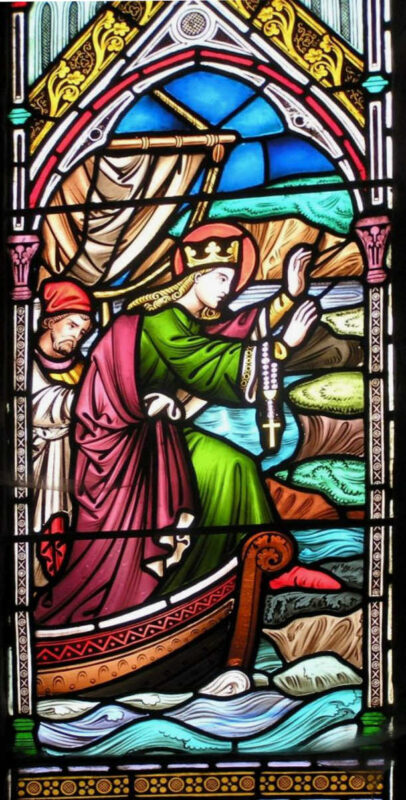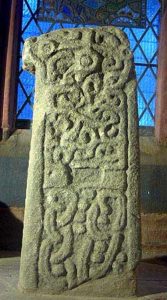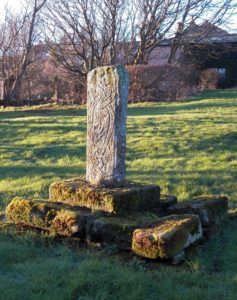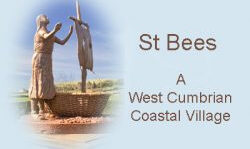Priory History - Pre Norman Conquest
St Bega
The stained glass window in the Priory vestry shows St. Bega landing at St Bees. She is our local saint and according to a medieval manuscript written centuries later, was said to be an Irish king’s daughter promised in marriage to a Viking prince who was “son of the king of Norway”. She evidently didn’t want this to happen, as the account says Bega “fled across the Irish sea to land in this remote spot on the Cumbrian coast. There she settled for a time, leading a life of exemplary piety. Then, fearing the raids of pirates which were starting along the coast, she moved over to Northumbria”.
She would most likely have arrived sometime after 850, when the Vikings were first settling Ireland. There is nothing to support the impossible date of 650 which is perpetuated even today by some writers, as there were no Vikings here until two hundred years later. It’s thought the medieval writer got his viking history mixed up, and everyone followed suit. There is also no evidence of a “Nunnery” – this is a piece of romantic history invented in the 1800’s. Rather, St. Bega would most likely have lived as a hermit or “anchoress”.
The name St Bees is a corruption of the Norse name for the village “Kirki-Becoc”; which can be translated as the “church of Bega”. The Priory possessed a venerated relic “the bracelet of St Bega”, which was the focus of the cult of St Bega and an object of pilgrimage; as late as 1516 there is record of offerings being made to it.
St Bega is associated in legend long after her death with a number of miracles, the most famous being the “Snow miracle”. This reads: “Ranulf le Meschin had endowed the monastery with its lands, but a lawsuit later developed about their extent. The monks feared a miscarriage of justice. The day appointed for a perambulation of the boundaries arrived – and, lo and behold, there was a thick snowfall on all the surrounding lands but not a flake upon the lands of the priory.”
For a fuller understanding of the St. Bega legends, you are strongly recommended to go to: “St Bega: Cult, Fact and Legend “
on this website, which is the latest definitive analysis of the known historical sources, and from which the above extracts are taken.

The first Christian evidence
The 10th century crosses
The spiral scroll cross
Little is known about the church before the Norman conquest and we must turn to fragments of stone, place-names and legends for help.
In about AD 600 the area became part of the Kingdom of Northumbria, and from about AD 850 onwards it was subject to occasional Viking raids. From about AD 925 the Vikings started to settle intensively in the area.
These crosses, in the grounds and in the Priory date from the 10th century.
At that time there would be no individual grave markers, and one cross would serve for all in the graveyard.

It is from the “Cumbrian spiral scroll” school of carving and both it and the Celtic cross below testify to the existence of a pre-Norman religious site.

The cross still standing in the Priory’s ancient graveyard to the north is a 10th century Celtic cross, the oldest carved stone in the parish.
The foundations of buildings found in exacavations and the carved stones tell us that that was a church here before the Normans came, and because of this it is likely they decided to build a much grander church on the site. There is the possibility that St. Bees Priory served as a “Minster church” for the Western Lakes. This would have been a “mother church” for the area.This is suggested by the the ancient parish boundaries and the juristriction of the Monastic Church later on.
There is an excellent article on this site by St Bees historian John Todd, which explores this subject in detail. See “The pre-Conquest Church in St Bees, Cumbria: a possible minster?“
